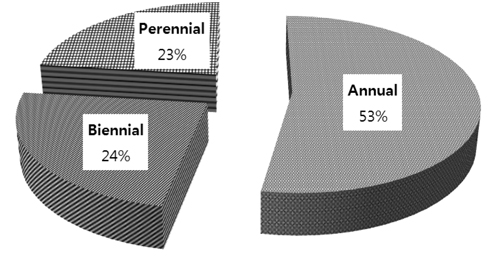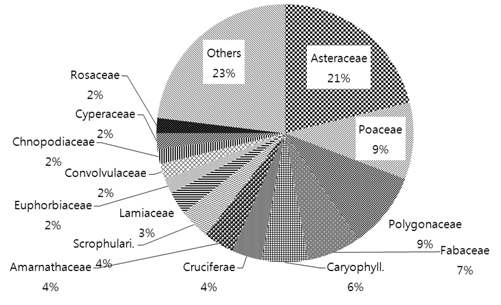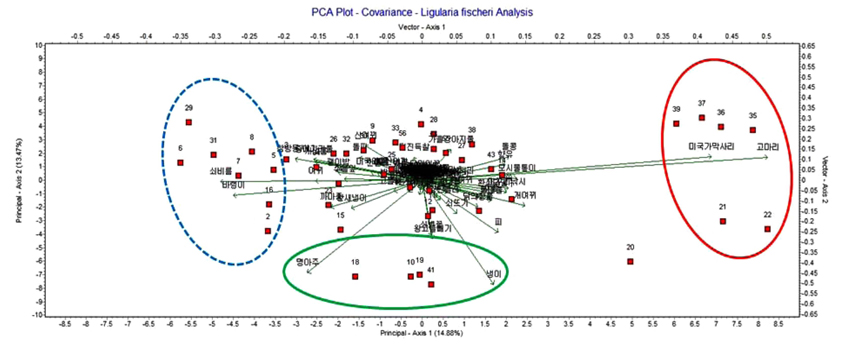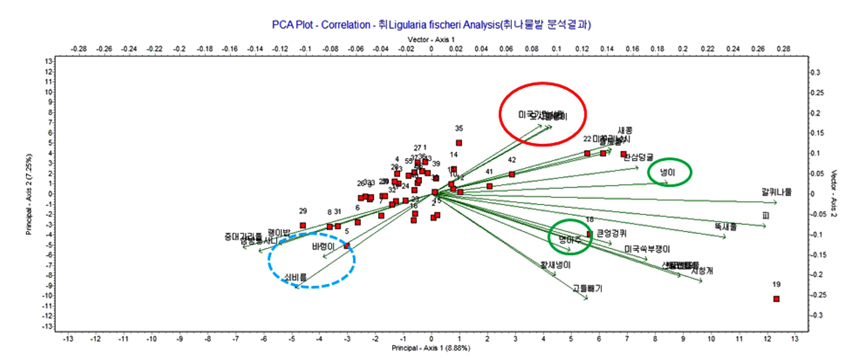



곰취밭에 발생하는 잡초발생 양상과 잡초로 인한 피해정도를 파악하여 곰취밭 잡초방제의 기초자료로 활용하기 위하여 2013년 5월부터 10월까지 5회 조사하였다. 곰취밭에 발생하는 잡초는 37과 104종으로 일년생잡초가 55종, 월년생잡초 25종 그리고 다년생잡초가 24종이었다. 이 중에서 외래잡초는 26종이 발생하였다. 우점도가 높은 잡초로는 명아주, 쇠별꽃, 돌피, 망초, 쑥 등이었으며, Ordination PCA 분석한 결과, 고마리-미국가막사리 군락, 명아주 군락 그리고 냉이 군락으로 분석되었다. 잡초에 의한 곰취의 피해 정도를 곰취 뿌리 무게로 비교한 결과, 잡초관리구에 비교하여 잡초방임구가 56% 작아져서 이듬해 곰취 생육에 영향을 줄 것으로 판단된다.
This study was conducted in order to utilize the basic data for weed control by surveying the occurrence of weed species and the degree of damages caused by those weeds occurred in cultivated
일반적으로 취나물이라고 하면, 곰취와 참취를 주로 말하지만, 취나물에는 6속 60여종이 있는 것으로 분류되고 있다(Choi et al., 2009). 이 중에 곰취, 참취, 개미취, 미역취, 수리취, 각시취, 곤달비 등 10여종이 산채로 주로 이용되고 있다. 이들 중 곰취(
곰취는 작기당 재배 연수는 3년으로 무경운 상태에서 영년재배가 가능한 산채로 주로 산에서 자라던 것으로 건강식품으로 각광을 받으면서 강원도 평창, 인제, 영월 등지의 노지나 시설에서 집약적으로 재배되고 있다(Choi et al., 2009; Kim, 2003). 곰취를 집단 재배할 경우, 산지(山地) 재배에서 문제되지 않았던 병해충 및 잡초문제가 발생할 수 있다. 그 동안 산채류에 대한 잡초분포조사는 Lee et al.(1998)이 보고한 것이 전부이다. 그러므로 농촌진흥청에서는 2013년부터 농촌진흥청, 도 농업기술원, 대학 및 산업체와 공동으로 ‘소면적 재배작물에 대한 병해충 및 잡초의 발생과 피해조사’를 실시하고 있다. 재배 면적은 좁더라도 농가에 고소득을 주는 작물에 대한 병해충 및 잡초를 조사하여 피해 정도를 파악하고 적정 농약을 선발하여 병해충 및 잡초 피해를 최소화할 필요가 있다.
따라서 본 연구는 곰취밭에 발생하는 잡초발생 양상과 잡초로 인한 피해 정도를 파악하여 곰취밭 잡초방제의 기초자료로 활용하기 위하여 수행하였다.
곰취밭에 발생하는 잡초는 2013년 5월부터 10월까지 총 5회 실시하였다. 조사지역은 주산단지인 강원도 평창, 인제, 정선으로 하였으며, 조사지점은 46지점, 면적은 21,600 m2이었다. 발생잡초는 각 시기별로 Braun-Branquet(1964)에 의한 7개 등급(r, +, 1, 2, 3, 4, 5)을 기준으로 피도(被度)를 조사하였다(Wikum and Shanholtzer, 1978). 각 단계별 잡초발생 정도는 Table 1 및 Fig. 1과 같다.
[Table 1.] Braun-Branquet scale by cover-abundance (Braun-Branquet, 1964).
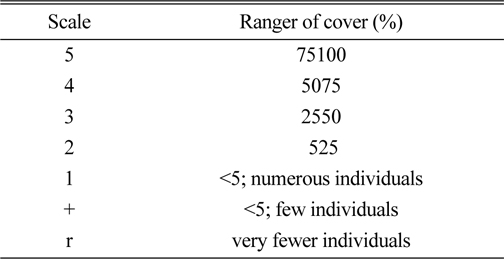
Braun-Branquet scale by cover-abundance (Braun-Branquet, 1964).
잡초조사 결과는 국가표준식물목록(KNA, 2007)에 의거하여 목록을 작성하였고, 외래잡초는 한국귀화식물 원색도감(Park, 2009)에 의해 표기하였다. 출현한 잡초종에 대해서는 Raunkiaer(1934)의 생활형을 기준으로 일년생과 다년생을 구분하였고 과별 분포 비율을 산정하였다. 잡초의 우점순위를 알아보기 위하여 중요치(IV)분석을 실시하였다(Curtes and Mc Intosh, 1950).
조사지역간 잡초종의 출현에 따른 차이를 파악하기 위하여 Ordination 분석은 각각PCA (principal component analysis)의 공변량(covariance)과 연관분석(correlation)을 실시하였다(Legendre and Legendre, 1998). 공변량과 연관분석의 자료 분석은 Seaby and Henderson (2007)의 Community analysis package 4.0 for window program을 이용하였다.
잡초에 의한 곰취 피해조사는 강원도 농업기술원 특화작물연구소 산채연구분소에서 실시하였다. 2012년에 이식(2012년 4월 21일)한 곰취를 대상으로 잡초관리구와 방임구를 두고 가을에 개체별 뿌리 무게 및 크기를 측정하여 (2013년 10월 8일) 피해 정도를 비교하였다.
곰취밭에 발생하는 잡초는 37과 104종(Table 2)으로 일년생잡초가 전체의 53%를 차지하는 55종, 월년생잡초가 24%로 25종, 그리고 다년생잡초가 23%로 24종이었다(Fig. 2). 이 중에서 외래잡초 26종으로 잡초 전체의 25%를 차지하며, 미국개기장, 가는털비름, 미국실새삼, 큰엉컹퀴 등이 발생하였다. 외래잡초의 하나인 미국실새삼은 전체적인 빈도나 우점도는 낮았지만, 조사지역 전체에서 골고루 발생하는 것으로 확인되고 방제 약제가 없어 향후에 문제가 심각해질 수 있는 잡초로 판단되었다. Kim et al.(2007)에 의하면 미국실새삼은 42과 88속 127종에 기생하는 등 기주범위가 넓고 특히 기주식물 중에서 국화과가 21%를 차지하여 곰취도 미국실새삼이 선호하는 기주식물 중의 하나이다.
[Table 2.] Occurrence of weed flora in Ligularia fischeri fields.

Occurrence of weed flora in Ligularia fischeri fields.
그리고 과별로 보면, 국화과 22%, 벼과와 마디풀과 각각 10%, 콩과 7%, 석죽과 6%, 그리고 비름과, 십자화과, 현삼과가 각각 4%순으로 발생하였다(Fig. 3). 밭잡초에서 과별 잡초발생 상황은 국화과, 벼과, 마디풀과 순이라는 Park et al. (2003) 보고와 유사한 경향을 보였다.
곰취밭에 발생하는 잡초 중 중요도(우점도)가 높은 상위 10초종은 명아주, 쇠별꽃, 돌피, 망초, 쑥, 쇠비름, 황새냉이, 냉이, 괭이밥 순이었다(Table 3). 자연상태의 곰취는 나무 사이에서 생육하며(Kim, 2003), 농가에서도 이와 유사한 햇볕이 직접 내리쬐는 곳보다는 비탈진 곳이나 차광막이 덮어진 그늘진 비닐하우스에서 재배하고 있다. 이런 재배적인 환경으로 인하여 밭에서 발생되는 모든 잡초가 다 출현하고 있다. 특히 음지이고 축축한 습윤상태이므로 쇠별꽃, 괭이밥 등이 유난히 발생이 많았다. Park et al.(2003)이 전국 밭잡초 조사결과, 우점 잡초는 국화과에서는 망초, 개망초, 쑥 등, 벼과로는 바랭이 등, 마디풀과는 여뀌, 소리쟁이 등, 십자화과는 냉이, 황새냉이 등이라고 보고와 유사한 결과를 보여주었다.
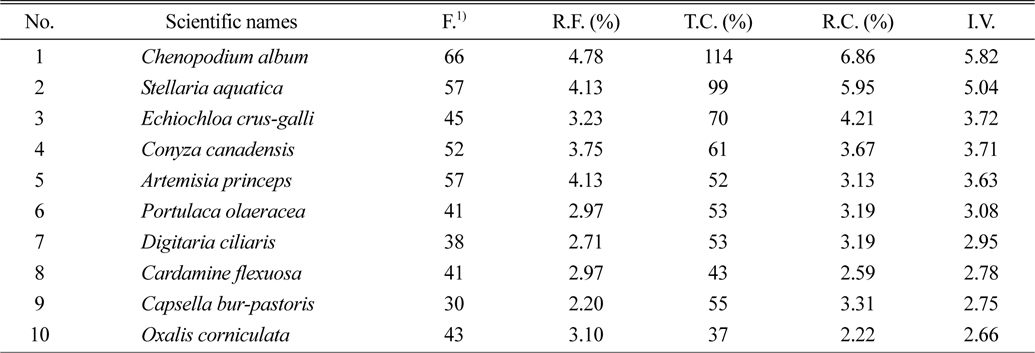
Occurrence of weed flora ordered by importance value in Ligularia fischeri fields (top 10 weeds).
PCA(principal component analysis) 분석은 군집생태에서 군락을 구성하는 방형구의 초종간의 분석이 우수하여 생태학에서 주로 이용하고 있다(JanžekoviË and Novak, 2012). 취나물밭에 발생한 잡초를 대상으로 PCA 공변량 분석을 실시한 결과, 조사지역 내 취나물밭 대표 잡초군락은 고마리-미국가막사리 군락(
쇠비름과 바랭이는 명아주 군락과 냉이 군락이 출현하는 방형구에서 비교적 높은 20~30%의 피도 값을 보이고는 있으나, 명아주와 냉이처럼 군락의 형태를 보이지는 않았다. 고마리-미국가막사리 군락에서는 미꾸리낚시, 미나리, 쑥, 털진득찰, 향유, 피, 개여뀌, 가을강아지풀, 까마중과 같이 논 잡초이거나 논둑에서 출현율이 높은 잡초들이 수반종으로 출현하고 있었다. 이는 대상지역이 답전윤환(paddy-upland rotation)의 재배방식으로 취나물을 경작하거나 혹은 과거 논으로 사용되어진 지역으로 사료된다. 망초, 쑥, 까마중, 쇠별꽃, 여뀌, 왕고들빼기, 황새냉이 등과 같은 일년생 및 다년생잡초가 수반종으로 출현한 명아주군락과 냉이 군락에서는 전형적인 밭 잡초들이 각 군락내 식생형태를 보였다.
PCA 연관분석은 군락 분석된 집단간의 연관성을 확인하여 이들 군락간의 상관관계를 보다 명확하게 유형화시키는 분석방법이다(Legendre and Legendre, 1998). 앞서 조사지역 내 취나물밭의 PCA 공변량 분석결과는 고마리-미국가막사리, 명아주, 냉이가 높은 우점도를 보이며, 취나물밭을 대표하는 군락으로 분석되었다. 이들 지역으로 출현한 초종을 대상으로 실시한 PCA 연관분석 결과, 고마리-미국가막사리 군락(
잡초에 의한 곰취의 피해 정도를 확인하기 위한 시험구에는 명아주, 쇠별꽃, 여뀌, 괭이밥, 망초 등이 발생하였으며, 뿌리 무게와 뿌리 길이에 대해 잡초관리구와 비교한 결과는 Table 4와 같다. 곰취는 잎을 5월부터 7월까지 채취하여 쌈채소 또는 데친 후 건조하여 판매하므로 곰취의 피해 정도는 처리구간의 누적치를 조사하여야 하나 시험여건이 원만하지 못하여 가을(10월)에 뿌리 무게와 길이를 비교하여 곰취의 피해 정도를 추산하였다.
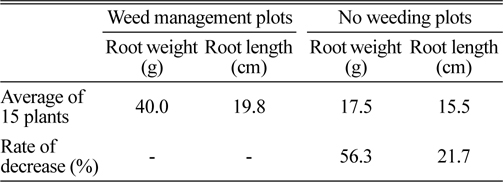
Comparison of Ligulari fischeri’s root weight and root length between weed management plots and no weeding plots.
잡초관리구의 곰취 주당 뿌리 무게는 40.0 g인 반면에 잡초방임구는 17.5 g으로 56.3%가 작았고, 뿌리 길이도 각각 19.8 cm과 15.5 cm로 잡초관리구에 비해 21.7%나 짧았다. 이는 곰취가 잡초에 의해 양분 및 광 경합에서 졌기 때문으로 판단된다. 이와 같이 잡초방임구의 곰취 발육상태가 불량하면, 이듬해 곰취 생산량이 절대적으로 적을 뿐만 아니라 종묘의 수명도 단축될 것으로 추론된다.
곰취를 재배하는 농가에서는 7월까지만 잡초관리하고 잎을 수확한 후에 방치하고 있었다. 곰취밭은 대부분 산과 인접한 관계로 다양한 잡초가 발생하고 있어 철저한 잡초관리가 필요한 실정이지만, 현실은 소득이 더 많은 작목에 관심을 기울이고 곰취밭에 발생하는 잡초는 그냥 방치하고 있다. 이런 잡초방임으로 이듬해 곰취의 잎 생산량이 감소되는 것은 물론이고 종묘의 수명도 단축되어 이중의 피해를 받을 수 있을 것으로 판단된다. 그러므로 내년도 곰취의 안정적인 생산과 종묘 수명 연장을 위해서는 최소 9월까지는 지속적인 잡초관리가 필요하다고 판단되었다.



